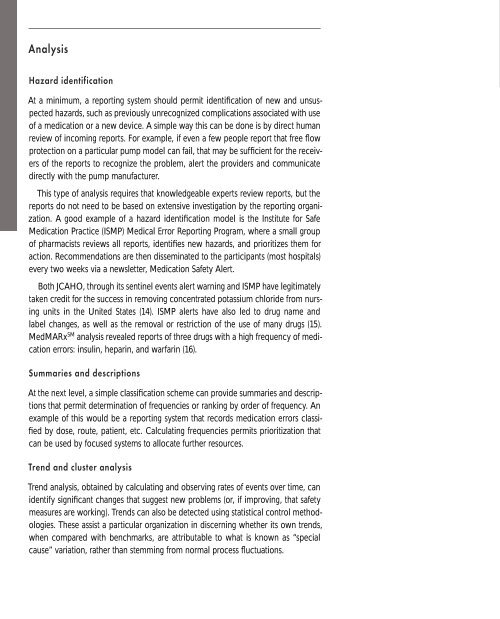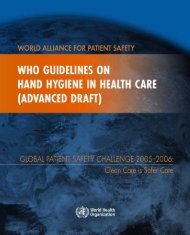Adverse event reporting.pdf
Adverse event reporting.pdf
Adverse event reporting.pdf
You also want an ePaper? Increase the reach of your titles
YUMPU automatically turns print PDFs into web optimized ePapers that Google loves.
Analysis<br />
Hazard identification<br />
At a minimum, a <strong>reporting</strong> system should permit identification of new and unsuspected<br />
hazards, such as previously unrecognized complications associated with use<br />
of a medication or a new device. A simple way this can be done is by direct human<br />
review of incoming reports. For example, if even a few people report that free flow<br />
protection on a particular pump model can fail, that may be sufficient for the receivers<br />
of the reports to recognize the problem, alert the providers and communicate<br />
directly with the pump manufacturer.<br />
This type of analysis requires that knowledgeable experts review reports, but the<br />
reports do not need to be based on extensive investigation by the <strong>reporting</strong> organization.<br />
A good example of a hazard identification model is the Institute for Safe<br />
Medication Practice (ISMP) Medical Error Reporting Program, where a small group<br />
of pharmacists reviews all reports, identifies new hazards, and prioritizes them for<br />
action. Recommendations are then disseminated to the participants (most hospitals)<br />
every two weeks via a newsletter, Medication Safety Alert.<br />
Both JCAHO, through its sentinel <strong>event</strong>s alert warning and ISMP have legitimately<br />
taken credit for the success in removing concentrated potassium chloride from nursing<br />
units in the United States (14). ISMP alerts have also led to drug name and<br />
label changes, as well as the removal or restriction of the use of many drugs (15).<br />
MedMARx SM analysis revealed reports of three drugs with a high frequency of medication<br />
errors: insulin, heparin, and warfarin (16).<br />
Summaries and descriptions<br />
At the next level, a simple classification scheme can provide summaries and descriptions<br />
that permit determination of frequencies or ranking by order of frequency. An<br />
example of this would be a <strong>reporting</strong> system that records medication errors classified<br />
by dose, route, patient, etc. Calculating frequencies permits prioritization that<br />
can be used by focused systems to allocate further resources.<br />
Trend and cluster analysis<br />
Trend analysis, obtained by calculating and observing rates of <strong>event</strong>s over time, can<br />
identify significant changes that suggest new problems (or, if improving, that safety<br />
measures are working). Trends can also be detected using statistical control methodologies.<br />
These assist a particular organization in discerning whether its own trends,<br />
when compared with benchmarks, are attributable to what is known as “special<br />
cause” variation, rather than stemming from normal process fluctuations.
















